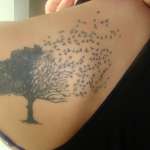Page 2
Risk FactorsOsteoporosis is due to a combination of factors. Older age and female sex are significant risk factors; after menopause, the risk of osteoporosis becomes much higher. Osteoporosis is also more likely in people with family members who have osteoporosis, as well as in thin, Caucasian, and Asian women. Girls and women who have a history of eating disorders including frequent dieting and poor nutrition are more likely to get osteoporosis. High-protein and low-calcium diets along with other bad lifestyle choices such as smoking and drinking excessively contributes to osteoporosis as well. Also, women who are inactive or do not participate in regular weight-bearing and resistive exercise are more likely to develop osteoporosis. Having a diagnosis of osteoporosis means your risk of fracture is four times greater than if you do not have it.
Risk Factors for Osteoporosis Fractures
(Charts adapted from the National Osteoporosis Foundation)
| Permanent | Modifiable |
|---|---|
| Having a fragility fracture* as an adult | Cigarette smoking |
| A close relative with a fragility fracture* | Not having a period for more than six months |
| Caucasian or Asian race | Diet low in calcium |
| Postmenopause | More than two alcoholic drinks per day |
| Female gender | Falling, poor balance |
| Lifelong history of absent periods | Low levels of activity |
| Bad eyesight (increasing fall risks) | Frail health |
| Early menopause (before age 45) | Weak muscles |
| Lifelong history of eating disorders | Hormone imbalance |
| Chronic health problems | Low-calorie or poor nutrition diet |
*Fragility fracture = a fracture occurring from a fall from standing height or lower
There are also certain medical conditions that make osteoporosis more likely, due to both the underlying disease and also due to side effects of medications for treatment. The most common medications that directly affect bone health are corticosteroids, often used to treat asthma, arthritis, and immune disorders. Women with hormone imbalances such as Cushing's disease, hyperparathyroidism, hyperthyroidism, and genetic sex hormone deficiency are also at higher risks. Also, diseases that cause disabilities to limit walking such as multiple sclerosis and spinal cord injuries can lead to thinning bones.
Risk Factors for Osteoporosis That Cannot Be Changed
| Factor | Explanation |
|---|---|
| Older age | With age, bone density decreases. |
| 15 percent of women in their 50s have osteoporosis; 50 percent of women in their 80s have it. | |
| Female sex | Women have a much greater risk than men. |
| Women have thinner lighter bones, less muscle mass to protect them, and are hormonally more susceptible. | |
| Family history | Genetics pre-programs a body to be susceptible to certain things such as osteoporosis and greater rate of fractures. |
| Small size | Small, thin people are more at risk. |
| Muscle and fat protect and strengthen bones. | |
| Other medical risks | Certain medical problems such as hypothyroid and hormonal imbalances lead to higher risks of osteoporosis. |
Risk Factors for Osteoporosis That Can Be Changed
15 Family History Tattoos to Inspire You
While tattoos aren’t for everyone, they’re often used as a way to honor someone, or a group of people that are closest to you. Family is something that will almost always be there for you, and many choose to honor them permanently by getting inked. Read More
| Factor | How |
|---|---|
| Low activity level | Those less active and less on their feet have weaker bones. |
| Bones get stronger the more they are used. | |
| Low-calcium diet | Calcium is necessary for bone formation; it is the basic substance of bones. |
| Smoking, excess alcohol | Excess alcohol and tobacco interfere with bone formation. |
| Not having periods during | Estrogen is needed for the delicate balance of hormones |
| reproductive years | to form and maintain bones. |
| High-protein diets | High-protein diets interfere with calcium absorption. |
The Role of Hormones
Estrogen is important to the bones' ability to absorb and retain calcium, maintaining structure and protecting bones from becoming weak. A regular menstrual period is the result of estrogen circulating through the body; therefore, women who do not get their periods regularly are at increased risk of having osteoporosis secondary to decreased estrogen levels. After menopause, estrogen levels decrease as well, contributing to the increased risk of osteoporosis. This is one reason estrogen supplements have been prescribed after menopause (other reasons include reducing uncomfortable side effects of menopause such as hot flashes). However, estrogen supplements only prevent osteoporosis and risk of fractures, they do not treat it. Although women who take estrogen after menopause actually do develop less fractures, the Women's Health Initiative, a groundbreaking study concluded in 2002, revealed that after five years of continuous treatment with hormone supplements, women can have slightly higher risks of breast cancer, blood clots, stroke, and uterine cancer. Therefore, prescribing estrogen supplements for postmenopausal women is no longer the treatment of choice. (If you are taking estrogen supplements after menopause, they should be at the lowest doses possible and taken along with progesterone to preserve a more natural body hormone balance; also, try not to take them for more than five years.)
